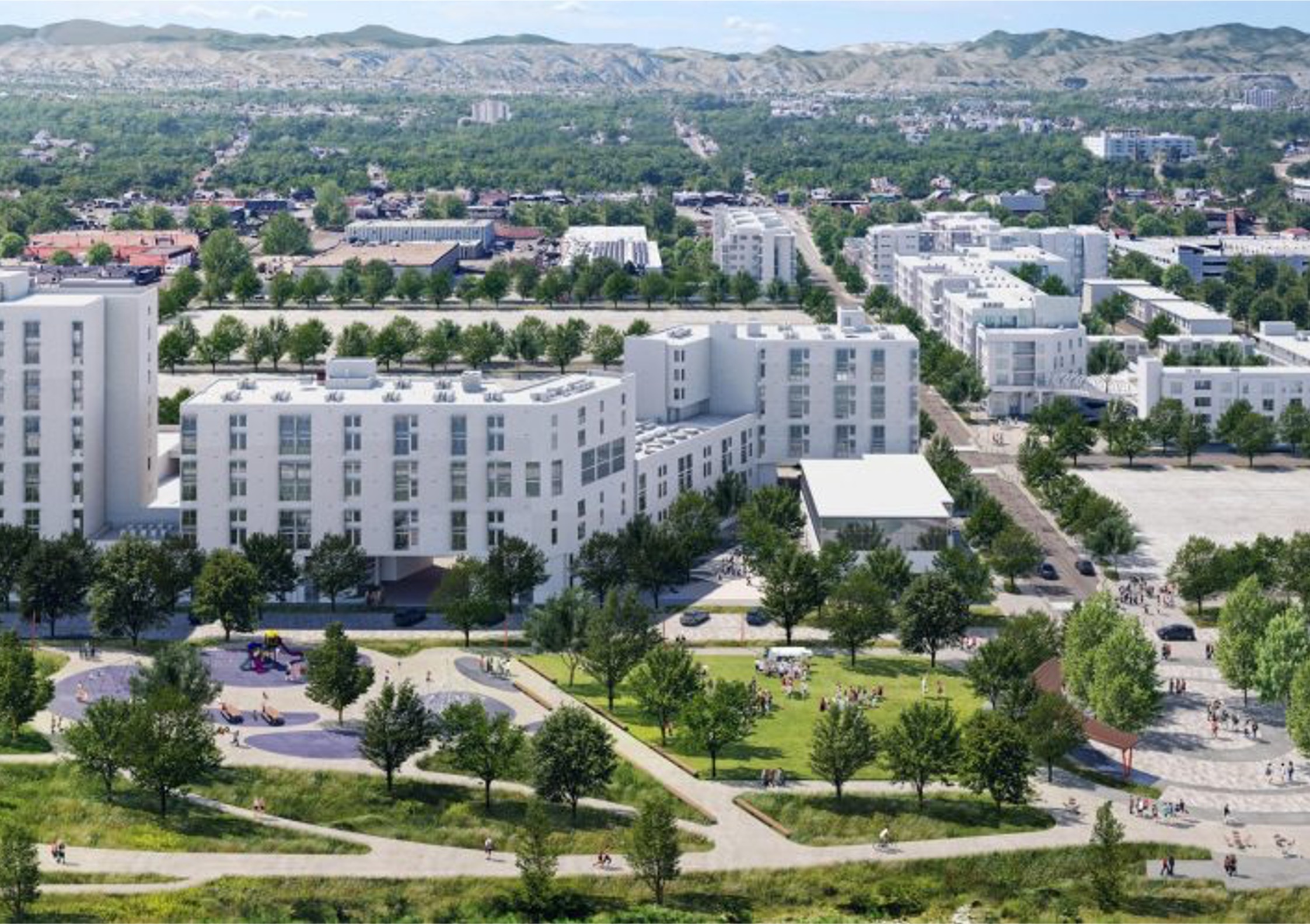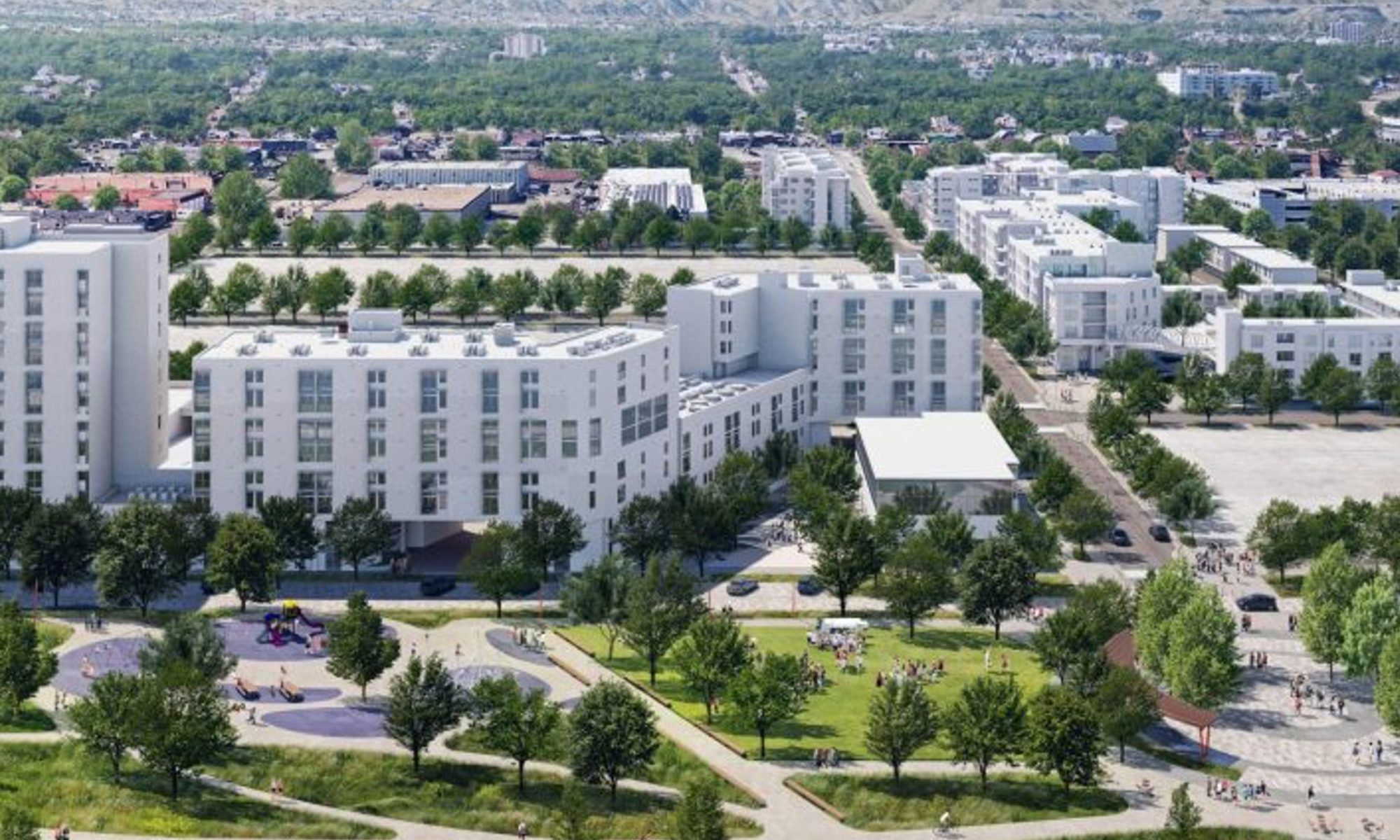Sun Valley is a neighbourhood being redeveloped by the Denver Housing Authority to ‘create a new model of community transformation with equity, environmental justice, and public health as its driving forces.’(1) The redevelopment aims to add 960 mixed income housing units (there were 333 existing public housing units on site); create 30,000 square feet of multi-use office space; redevelop 3.2 acres of industrial use buildings into a mixed-use area; and establish a new light rail station. The Sun Valley Eco-District was established to ensure that this DHA project built successfully on the strong credentials of the Mariposa redevelopment.
Considering health, equity and other social factors has been essential in project planning as the population living in Sun Valley face multiple barriers to healthy living. Over 80% of residents live below the poverty line, a quarter identify as first-generation immigrants, a fifth are refugees, and 94% live in subsidised housing.(1) Although the neighbourhood is centrally located, it is low density and primarily industrial. Denver’s Comprehensive Plan (2014) promotes the development of an equitable, safe, economically vibrant and healthy neighbourhood.
This project is featured as one of our healthy urban development case studies.
| Location | Denver, Colorado USA |
| Project type: | Mixed-use (primarily residential) |
| Project size: | 100 acres |
| Goals: | Equitable, affordable and inclusive; Strong and authentic neighbourhoods; Connected, safe, and accessible places; Economically diverse and vibrant; Environmentally resilient; Healthy and active |
| Date started: | 2013 planning started |
| Date completed: | Ongoing |
| Stakeholders: | Denver Housing Authority, SA+R (architects), Liveable Cities Studio, Matrix Design Group |
| Website: | https://www.sunvalleyredevelopment.com/ |
Health and wellbeing
The Denver Housing Authority (DHA), the developer on this project, created the Sun Valley Healthy Living Initiative (SVHLI) to address health from the outset. The initiative’s priorities include education, active lifestyle, mental health, healthcare access, safety and security, and social cohesion.(2)
Sun Valley’s redevelopment is underpinned by a principle of connection that will support physical and mental health and wellbeing by:
- providing a variety of public spaces and amenities to promote public life
- the development of a mobility network to connect people within and beyond the neighbourhood
- increasing the diversity of land uses to promote an active and liveable neighbourhood.
A summary of the design features and planning processes at Sun Valley that contribute to health and wellbeing are listed in the tables below, as they relate to the scales of health impact and core principles of the THRIVES framework.(3) The information in the tables draws from limited published materials (1,4) and more information may be added if it becomes available.
| Planetary health | The Sun Valley EcoDistrict received a grant from the US Environmental Protection Agency in 2014 for energy and planning including modelling district-based energy solutions and small-scale green infrastructure solutions. The district aims to build a district-wide energy system which could potentially decrease the annual energy use by 20%. They also aim to install solar PV to generate 30% of the development’s annual electricity needs. The river restoration project restores natural habitats. |
| Ecosystem health | Sun Valley is located at the confluence of two water systems running into the South Platte River. Since 2010, over $4 million has been invested to restore the river systems, create open waterways and landscape the river banks. This restoration has improved the environment quality and flood control. Active transport and perceived safety are improved through newly designed streets, paths and sidewalks through and to the neighbourhood, and new pedestrian access to the river, the light rail station and buses. New bicycle storage has been installed and Denver’s B-cycle bike share program will provide two new bike share stations. |
| Local health | The SVHLI has a strong emphasis on economic opportunities that bridges equity and inclusion. The Opportunity for All campaign offers business support and jobs training, early childhood education and after school programmes. New businesses will be supported through the Sun Valley Eco District incubator for micro-restaurants and micro-retail. A new 30,000 square foot multi-use office building provides space for community activities, a resource library, art gallery, and food services. More than 60% of the new housing would be public and affordable housing. |
| Inclusion | The Sun Valley Healthy Living Initiative has numerous strategies that support inclusion, specifically within the Safe & Inclusive campaign such as, street safety & mobility, art & cultural expressions, anti-displacement, and ergonomic / universal design. The Pause & Connect initiative outlines measures to reduce social isolation and connect residents through programmes and events in the community. |
| Equity | Equity was explicitly included in the Sun Valley redevelopment, specifically in the Stadium District Master Plan document.(5) The master plan, which includes the redevelopment of what is now called Sun Valley, identifies three themes within the equity goal: 1. Improving equitable access to opportunities such as quality education, basic services, and amenities to redress differences in life outcomes experienced disproportionately by Denver’s low-income and racially diverse populations. 2. Reducing residents’ vulnerability to displacement resulting from increased property values and rents after development. 3. Providing a diversity of housing options including different prices, sizes, types, and a mix of rental and for-sale units, and quality employment options. |
| Sustainability | A sustainability strategy was developed for the project, building on stakeholders’ involvement in a 2013 EcoDistrict Incubator event. This led to the establishment of the Sun Valley EcoDistrict which builds on and learns from previous EcoDistrict projects. |

Achievements
Planning and initial progress at Sun Valley have shown promising achievements for equity, inclusion and sustainability. The project is still in development, and additional achievements will need to be evaluated in future work.
Lessons learned
Key lessons learned relate to governance, coordination and funding:
- Land ownership and master planning authorisation were reported as project challenges as the Sun Valley Station Area land is larger than Denver Housing Authority’s redevelopment area.
- Coordination across the existing public and non-profit anti-poverty initiatives in West Denver is needed. The Sun Valley Eco District aims to become a hub for these activities to facilitate more integration of services and initiatives.
- Relocation remains a challenging process for some residents despite the phased relocation plan. There are negative perceptions about the redevelopment that need ongoing attention to ensure growth is inclusive and beneficial for all.
- Connecting Sun Valley with downtown Denver remains challenging as major infrastructure, such as a highway and the football stadium, create physical barriers. The development’s efforts to improve connectivity may have limited impact on changing perceptions of accessibility. Sources of further funding for infrastructure development remain uncertain.
More information
- Denver Housing Authority, n.d. Sun Valley Redevelopment.
- Mithun, 2019. Sun Valley Healthy Living Initiative / Action Plan.
- Pineo, H., 2020. Towards healthy urbanism: inclusive, equitable and sustainable (THRIVES) – an urban design and planning framework from theory to praxis. Cities Health 0, 1–19.
- EcoDistricts, n.d. Sun Valley Neighborhood. EcoDistricts Target Cities.
- Denver City Council. 2019. Stadium District Master Plan.

